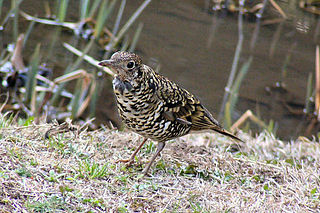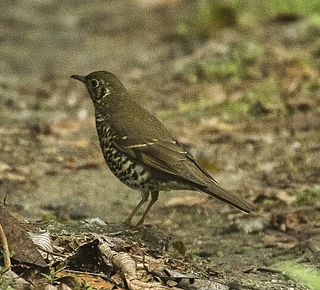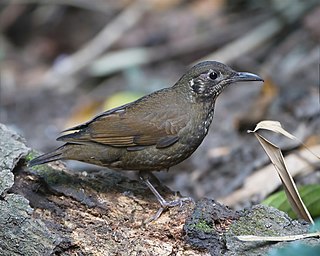Plain-backed thrush is a common name for a broad species concept of Zoothera Mollissima . The bird has been split into the following species:
- Alpine thrush, Zoothera Mollissima
- Sichuan thrush, Zoothera Griseiceps
- Himalayan thrush, Zoothera Salimalii
Plain-backed thrush is a common name for a broad species concept of Zoothera Mollissima . The bird has been split into the following species:

The orange-headed thrush is a bird in the thrush family.

The scaly thrush is a member of the thrush family Turdidae.

White's thrush is a member of the thrush family, Turdidae. It was named after the English naturalist Gilbert White. The genus name Zoothera comes from the Ancient Greek zoon, "animal" and theras, "hunter". The specific aurea is from Latin aureus, "golden".

The Asian thrushes are medium-sized mostly insectivorous or omnivorous birds in the genus Zoothera of the thrush family, Turdidae.

The pied thrush is a member of the thrush family found in India and Sri Lanka. The males are conspicuously patterned in black and white while the females are olive brown and speckled. They breed in the central Himalayan forests and winter in the hill forests of southern India and Sri Lanka. Like many other thrushes, they forage on leaf litter below forest undergrowth and fly into trees when disturbed and sit still making them difficult to locate.

The geomalia or Sulawesi mountain thrush is a rare member of the thrush family endemic to Sulawesi in Indonesia. It is sometimes classified as Geomalia heinrichi, in which case it is monotypic in the genus Geomalia.

The Bonin thrush, also known as Kittlitz's thrush or the Bonin Islands thrush, is an extinct species of Asian thrush. It is sometimes separated as the only species of the genus Cichlopasser. The only place where this bird was found was Chichi-jima in the Ogasawara Islands; it might conceivably have inhabited Anijima and Otōtojima, but this has not been borne out by observations or specimens. The species was only once observed by a naturalist, its discoverer Heinrich von Kittlitz. He encountered the thrush in the coastal woods where it usually kept to the ground; it may have been ground-nesting. The only specimens ever taken are in the Naturalis in Leiden (1), the Naturhistorisches Museum in Vienna (1), the Senckenbergmuseum in Frankfurt (1) and in the Zoological Museum, St. Petersburg (2).

The Bassian thrush, also known as the olive-tailed thrush, is a medium-sized mostly insectivorous thrush found from northern Queensland to southeastern Australia; it also occurs in Tasmania, on some larger islands of Bass Strait, and on Kangaroo Island. The thrushes range from 27 to 29 cm in length and average 100 g (3.5 oz).

The long-tailed thrush is a species of bird in the family Turdidae. It is found from the central and eastern Himalayas to south-central and south-western China. Its natural habitats are subtropical or tropical moist montane forests and subtropical or tropical high-altitude shrubland.

The dark-sided thrush is a species of bird in the thrush family Turdidae. It is also known as the lesser brown thrush, the long-billed ground-thrush, and the dark-sided ground-thrush. The species is monotypic and is closely related to a number of thrushes in the genus Zoothera, including the long-billed thrush and the widespread scaly thrush. It was described by Edward Blyth in 1847 based upon a specimen collected in Rakhine in Burma (Myanmar).

The alpine thrush is a species of bird in the thrush family.

The long-billed thrush is a species of bird in the family Turdidae. It is found from the Himalayas to Myanmar and Vietnam. Its natural habitat is subtropical or tropical moist montane forests.
The Moluccan thrush has been split into two species:
The name grey thrush can refer to several species of bird:

The Sri Lanka thrush or Sri Lanka scaly thrush is a member of the thrush family Turdidae. This bird is a non-migratory resident breeder found in south western rainforests of the island of Sri Lanka.

The Geokichla thrushes are medium-sized mostly insectivorous or omnivorous birds in the thrush family, Turdidae. They were traditionally listed in the Zoothera, but molecular phylogenetic studies published in 2008 led to their placement in a separate genus.

The Himalayan thrush or Himalayan forest thrush is a species of bird described in 2016 and separated out from the alpine thrush Zoothera mollissima with which they were formerly lumped. The species is separated on the basis of phylogenetic studies that suggest that the population diverged from the common ancestor at least 3 million years ago. The alpine thrush breeds above the tree line whereas the Himalayan thrush breeds in forested habitats. The species breeds from Sikkim and Darjeeling in India and extends east into Tibet and further east into northwest Yunnan in China. The species differs in its song from that of the alpine thrush. The Himalayan thrush has a more musical call while that of the Alpine thrush is raspy and grating. A newly discovered Himalayan forest thrush bird was named after the birdman of India, Ornithologist Dr.Salim Ali. The name of the bird is "Zoothera salimalii". A fruit bat is also named after him "Latidens salimalii"
The year 2016 in birding and ornithology.
The white-bellied thrush has been split into the following species: